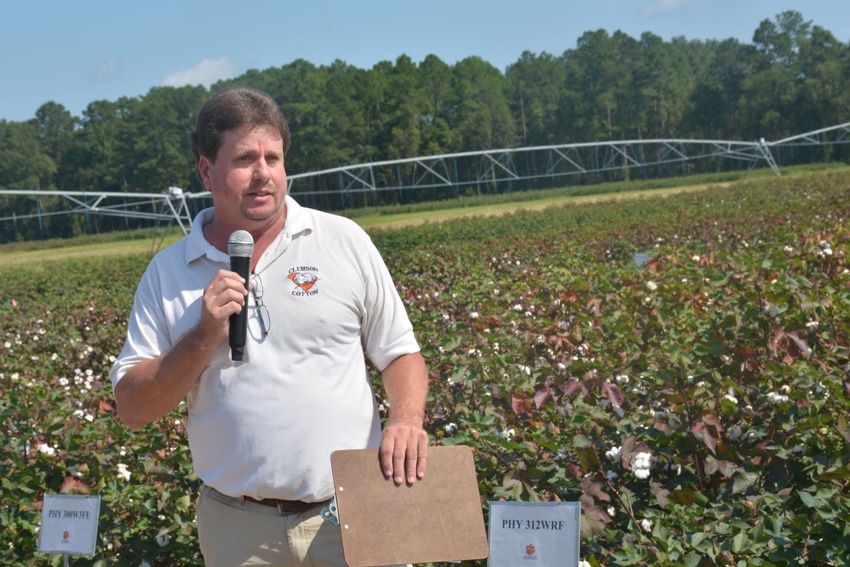
South Carolina cotton farmers are hoping weather cooperates until the very last cotton field is harvested this year. They are on track to produce their best cotton crop ever, and they need it.
Following two back-to-back years of rain-damaged crops, South Carolina is due a good cotton crop this year. Speaking at the annual field day at the Pee Dee Research and Education Center in Florence, Sept. 7, South Carolina Cotton Specialist Mike Jones highlighted USDA’s September crop report that put the statewide average yield in South Carolina at 960 pounds per acre, a record. The old state record was 955 pounds in 2012.
Jones noted that USDA can be a bit high in its crop estimates, but he said the crop does look excellent across the state. “Driving around and talking to county agents, I haven’t seen a bad cotton crop here in South Carolina, Most of it is loaded up pretty good,” Jones told field day attendees.
USDA puts South Carolina cotton acreage at 250,000 acres, up from 198,000 acres last year. Jones notes that USDA rates the crop 98 percent good to excellent, which has never happened in South Carolina.
“Unless another hurricane comes through, I think we’re going to have a pretty good crop. It’s starting to cut out like it should so hopefully we’ll get it out of the field and have a pretty good harvest,” Jones said.
Turning to production advice, Jones emphasized the importance of plant population and having enough plants in the field to produce maximum yields. “I think we’re starting to push our seeding rates a little too low,” the cotton specialist said.
“Our ideal plant population, in my opinion, is about three plants per foot row in a 38 inch or 40 inch row. But research has shown that if we can get from 1 to 1.5 plants per foot row, it is just as good as 3 to 3.5,” he said. “I know you guys like to hear that because that’s going to save you some money on your technology fees and your seeds. The only issue with that is it’s going to delay your maturity by two to three weeks cutting your seeding rate that low.”
Jones said most years this isn’t a problem, but with the threat of hurricanes and rainy weather, it is something to consider. “If you get down below one plant per foot of row, you’re looking at a 20 to 30 percent field decrease right off the bat. We don’t want to go that low. That’s pushing it too low,” he emphasized.
In the meantime, Todd Campbell, a USDA research geneticist based at the Pee Dee Research and Education Center, emphasized the importance of genetic diversity in cotton varieties. He called genetic diversity a “long-term insurance policy” that is critical for the continued improvement in cotton varieties.
“You may not see the impact of genetic diversity next year or the year after that or even within five years, but there is a lot of substantial evidence out in the scientific community in cotton that has demonstrated a narrowing of the genetic base in cotton,” Campbell said. “Breeders need new genetic diversity, new traits, new resistance genes and new genes that improve fiber quality. We need to be able to integrate those in varieties of the future.”
Campbell said cotton germplasm that offers improved fiber quality is paramount. “If it doesn’t have good fiber quality, it gets thrown out. There is a real delicate balancing act when you’re a cotton breeder when you’re trying to select for high yield and for high quality. It sounds easy, but it’s really difficult. When you get high quality, typically your yield goes down and vice versa.”

USDA Research Geneticist Todd Campbell said genetic diversity is a “long-term insurance policy” for cotton.
About the Author(s)
You May Also Like






